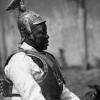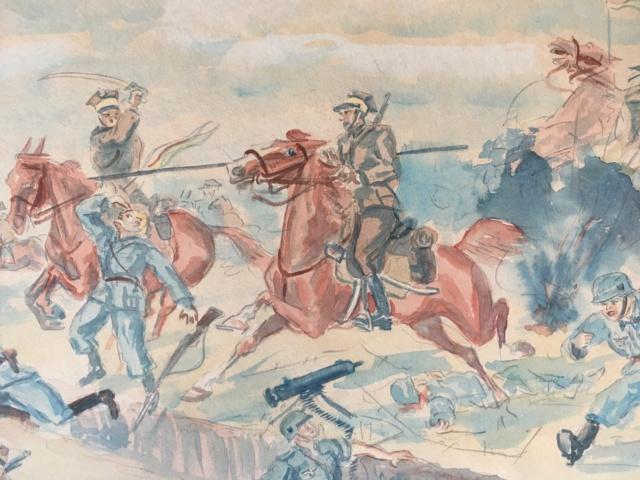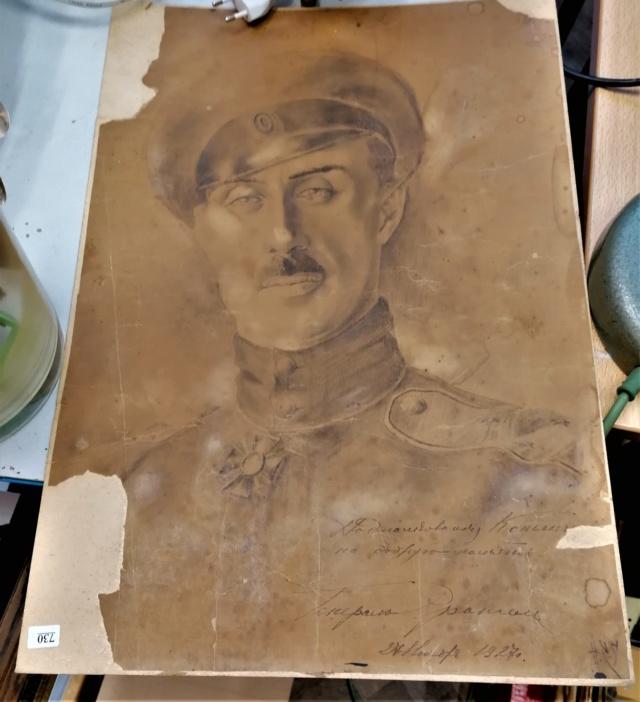-
Posts
1,991 -
Joined
-
Last visited
-
Days Won
3
Content Type
Profiles
Forums
Blogs
Gallery
Events
Store
Everything posted by Stuka f
-

Opinions on French 1822 Cavalry Sword with the German Blade
Stuka f replied to Volovonok's topic in Swords & Edged Weapons
Klingenthal was the name of a blade factory in Mohlsheim, Mutzig and Gresswiller even named Clinquethal at one point (1735). The region changed several times from France to Germany during history and wars. Nothing uncommon to see French swords have Klingenthal marks. -
Nice, thanks for sharing.
-
Here is a portret with dedication of General Wrangel... I sadly mist on a recent auction.... Great gift btw!
-
That is a chasseurs of the Papual zouaves.
-
Indeed. The medal was given 25 to 30 years after the facts to every zouave still alive. The document also says "the proves that he gave of his devotion even after the regiment was dissolved" ...must mean something! ?? As a child I was allways fascinated by the Papual zouaves on display at our national museum. I have been searching for flemish volunteers stuff ever since. I am nearly 60 and here it is.
-
It is in, some better pic's; The document says; la santita di nostro signore si é degnata concedere una distinzione onorifica al soldat comune De Wispelaere Basile dei zuavi pontificii in attestato dei servizi resi nelle difesa della sant sede e delle proveche ha dato della sua divozione anche dopo che il corpo venne disciolto. Il tenente colonello comandante il reggimento ha il piacere di transmettere al medesimo la medaglia di bronze secondo il tenore del breve del dieci. Marzo mille ottencento novant uno il cui originale si conserva nell archivio della secretario del stato. Per ordine Charette Basse Motte 27giugno 1891 In English; the sanctity of our lord deigned to grant an honorary distinction to the common soldier De Wispelaere Basile of the pontifical Zouaves in attestation of the services rendered in the defense of the holy see and the proves that he gave of his devotion even after the regiment was dissolved. The lieutenant colonel commanding the regiment has the pleasure of handing him the bronze medal according to the tenor of the ten short (!?). March one thousand eight hundred ninety one, the original of which is kept in the archives of the state secretary. By order Charette Basse Motte 27th June 1891
-
Yes they certainly did, and a very elaborated answer. I was very pleased about this contact.
-
When you remove the chin straps, you should be able to notice the regiment marks under the cocards, can you show these? And probably on the white tombac reinforcements edges, or on the inside around the spike emplacement, you should notice a makers mark (Jäeger, Lachmann, or any other...), is there any?
-
Thanks for your reply. Would love to see them. There is a original and nicely framed pic for sale at the momment on the Belgian "tweedehands" site. The guy seemed to have the uniform too, but sold it.
-
A very different item I have had on my secret list for years. Some of the things you do not expect to come by, ever... A medal to a Flemish Papal Zouave! Flanders has allways be a land of landsknechten but specialy for the Vatican, many Flemish boys enlisted. I am not religious but just, like the TR periode, this chapter of our history do interest me. It is not in yet, so better pic's will come up later.
-
Thanks Paul.
-
I also send a request to when I was doing my research nearly a month, maybe two... ago. To the national museum of Colombia. Here is what I got yesterday; Dear Sir, Thank you for addressing the National Museum of Colombia for your inquiries. We are delighted to know about your Colombian embassy portfolio or briefcase. Please excuse the delay in our response, the History Curatorial Department has been gathering all possible information that would help your better understanding for this historical artifact. Our researcher Santiago Robledo has kindly assembled the following data. Historically speaking, New Granada [Nueva Granada] was the name given by the Spaniard colonizers to the territory currently occupied by the contemporary Republic of Colombia (1886). In the XVIII century, the Spanish Crown established this viceroyalty known as the Viceroyalty of New Granada [Virreinato de la Nueva Granada] or the Viceroyalty of Santafé, the latter denomination referring to its capital city: Santafé de Bogotá. In the 1810s, during the first period of emancipation from the Spanish dominion, the local creole juntas created a state named the United Provinces of New Granada [Provincias Unidas de la Nueva Granada] (1811-1816). Later on, after the definitive Independence in 1819, general Simón Bolivar (1783-1830) and congressmen representing the different ex American-Spanish provinces created the first Republic of Colombia [República de Colombia] (1819-1830). That Great Colombia, as it is known by the traditional historiography, was integrated by the territories occupied by the modern nations of Ecuador, Venezuela, Panamá, and Colombia. The first Republic of Colombia dissolved in 1830, so in 1831 appeared three new states: The State of Venezuela, the State of Ecuador, and, reverting to its original name, the Republic of New Granada [República de la Nueva Granada] (1831-1858). This last republic included modern Colombia and Panamá. In 1858 New Granada became a federalist state and thus was baptized the Grenadine Confederation [Confederación Granadina] (1858-1863). Later, after a civil war won by the Liberal Party, that confederation was renamed the United States of Colombia [Estados Unidos de Colombia] (1863-1886). Finally, in 1886, a new constitution imposed by the conservatives and the moderate liberal parties ended the federalist regime and established a centralist republic. Since that moment, the country located in the northwest corner of South America has been known as the Republic of Colombia. At the beginning of the XX century, in 1903, Panama separated from Colombia. The coat of arms embroidered in your portfolio was originally adopted in 1834 as its official sigil by the Republic of New Granada (1831-1858). The cornucopias with mineral and agricultural wealth were supposed to represent the economic potential of the country, and the small pomegranate fruit [granada] located between them evocated the country´s original Spanish name. The Phrygian cap symbolized liberty and the isthmus of Panama represented the commercial potential of a republic located in the crossroads of the Atlantic and the Pacific. That same coat of arms was kept as the official symbol of all of New Granada´s successor states, including the current Republic of Colombia (even though Panama ceased to be part of the country). During the federal regime, the coat of arms frequently was surrounded by nine stars that symbolized the sovereign federal states. This description renders iconographical explanation for the embroidery in your portfolio. We were not able to find much about Louis David-Verbist (1806-1871). Nonetheless, some primary sources allow us to establish that he was New Granada´s consul in Antwerp for the greater part of the 1850s. “Luis David” was named as such in 1852 (Plata, 1852, 45), 1854 (Pinzón, 1854, document No.1), 1857 (Pombo, 1857, document No.16) and 1858 (Pardo, 1858, 48). In 1859 he even appears as the Grenadine Confederation´s consul in that city (Pardo, 1859, Cuadro XXXVIII). Sometime shortly after that, he ceased to act diplomatically in Antwerp for the Confederation. “Henry Wonder Bec” was listed as the country´s representative in the city from January 20, 1862, to August 31, 1863 (Congreso,1866,134). The fact that in the portfolio the country is named “República de la Nueva Granada” allows us to speculate that it was manufactured before 1858. That, additional to the span of David-Verbist´s tenure as consul, also suggests a tentative dating of circa 1855 for your historical artifact. For a brief introduction to Colombia´s history you may be interested in Marco Palacios and Frank Safford´s book Colombia. Fragmented land, divided society (New York-Oxford: Oxford University Press, 2002). Sources cited: Congreso de los Estados Unidos de Colombia. Acos lejislativos del Congreso de los Estados Unidos de Colombia en sus sesiones de 1866. Bogotá: Imprenta de la Nación, 1866. Pardo, J.A. «Esposicion del Secretario de Relaciones Esteriores de la Nueva Granada al Congreso de 1858 (conclusión)». Gaceta Oficial de la Nueva Granada, No. 2209, lunes 8 de febrero de 1858, 48. Pardo, J.A. Informe del Secretario de Relaciones Esteriores de la Confederacion Granadina al Congreso Nacional de 1859. Bogotá: Imprenta de la Nación, 1859. Pinzón, Cerbeleón. Informe que el Secretario de Relaciones Esteriores de la Nueva Granada presenta al Congreso de 1854. Bogotá: Imprenta del Neo-Granadino, 1854. Plata, José María. Informe del Secretario de Estado del despacho de Relaciones Esteriores de la Nueva Granada a las Cámaras legislativas de 1852. Bogotá: Imprenta del Neo-Granadino, 1852. de Pombo, Lino. Esposicion del secretario de Relaciones Esteriores al Congreso de la Nueva Granada en sus sesiones ordinarias. Bogotá: Imprenta Estado, 1857. Best regards, .............. Curadora Jefe de Historia / Curator chief for the History Curatorial Department Museo Nacional de Colombia - Ministerio de Cultura de Colombia / National Museum of Colombia – Colombia Ministry of Culture Tel: (57-1) ............ Dirección: ................. Bogotá, Colombia
-
Thanks.
-
I do Bayern.
-
Ok, thanks.
-
hello, someone just asked me for anything related to North African and Middle East masonic items. I didn't know they even existed. He is looking for anything, even comtempory books or information. Can anyone help us, please?
-
Hey Bayern, thanks. I saw that too, but what I am interested in is the periode my map is related to.
-
Thanks fot your reply, Paul.
-
Thanks. But that is wath it says on the wikipedia page. What I am curious after is, the uniforms, the army organisation. Did they created medal orders etc..






.thumb.jpg.b08655c61ea71377ae1a51c8a6f42207.jpg)